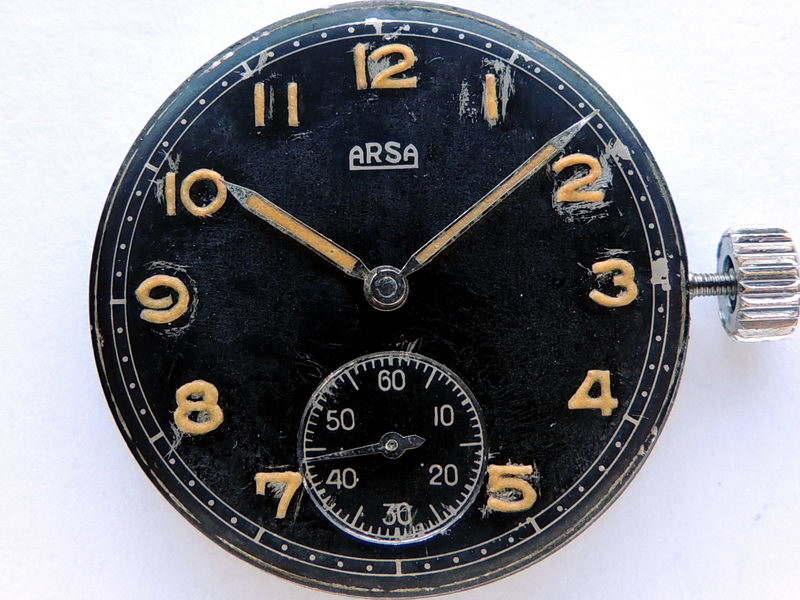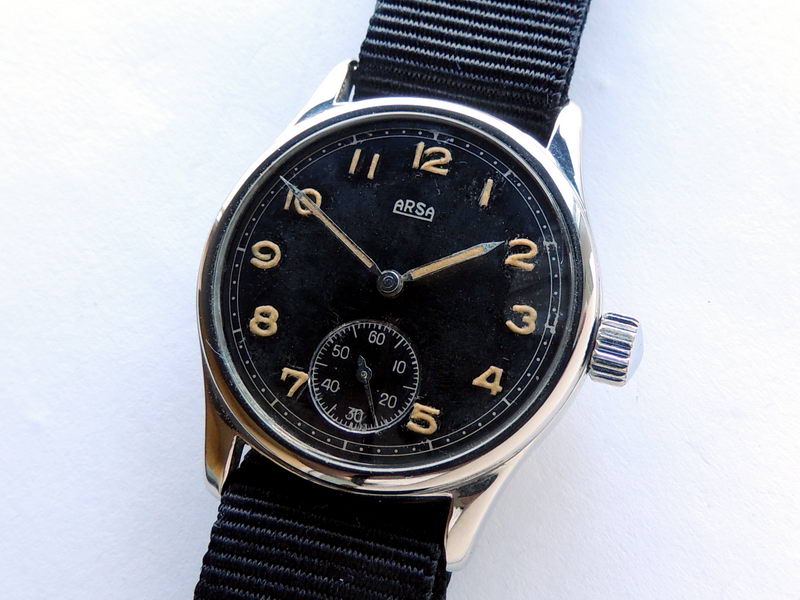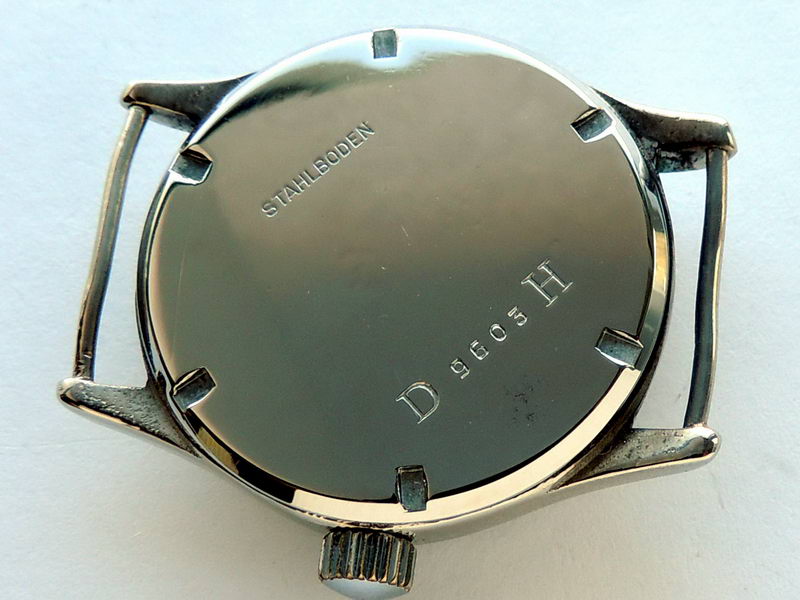Restoring the Dial After an Unsuccessful Repair
A real WWII German soldier’s watch is of course a dream to own for many, and this one is no exception. This authentic wristwatch even bears the original signature “D. H.” – initials that stand for the name Deutsches Heer.
The Victim of “the Painter”
Tragically, this watch somehow fell into the hands of a ‘shoe repair shop’ watchmaker, who clearly lacked the talent and motivation to do a good job. He is the reason why, unfortunately, the watch face has literally been painted over the original dial. Have a look at the result…

As you can see, the digits can barely be seen from under the wrinkled and scratched plastic, and the dial has been completely ruined by the watchmaker.
Hoping for the best and dreading the worst, we opened the dial, under which we found the face of the poor victim. This watch is a prime example of how a bad watchmaker can pose such a danger to a watch – the watch’s worst enemy, in this case, is the master who tried to repair it. The owner of a watch can hit it, scratch the surface, and even wear out the strap, all of which is fully and utterly repairable. But only the ‘master’, the watchmaker himself, can place his hands inside the watch and create an even bigger mess than before. Here is an example:

The dial is covered in a terrible and destructive layer of tar, and the numerals around the sides are smudged with it.

Instead of the numerals, there are barely legible white blobs of paint, a paint which also covers the hands of the watch. The rough and uneven polish gives off an ugly shine.
In this case, the master was most likely attempting to get rid of the radioactive paint from the original watch face by scratching the numerals from it and then, in an effort to express his ‘inner artist’, painted on a new set of numbers over the top. The surface has been painted with a thick layer of black tar, with just a small gap on the surface left for the seconds disk and a yellowy polish covering over the numerals.
There are two ways of fixing this watch:
- Typographical Restoration: Removing all of the paint until just the metal is visible.
- Manual Restoration: Attempting to remove the paint layer by layer until eventually the original colour is reached. However, with this method, you don’t know what result you’re going to get until you’ve completed it.
We’ll start with method number 2 first, and if this doesn’t work, we will try method number 1. If we remove all of the paint layer by layer, in theory we will eventually reach the original surface. But we will see how it goes, and if we need to, we’ll try to make it look better using other methods.
Step 1: Cleaning
There are many different solvents that you can try for different types of dial. We tried to clean the face using gasoline, kerosene, and alcohol, but there was no change… Until we started cleaning the dial with nail polish remover, which finally began to remove the yellowy polish.

The nail polish remover is absorbed by the tar, and soon it starts to become easier to remove.

We need to place a piece of cotton soaked in the nail polish remover onto the dial in order to get the tar to dissolve.

The black tar, covered in the remover, is disappearing quickly – soon we can get rid of it.

The tar is coming off, but the white paint isn’t coming off the dial as easily, and so far, it’s only been softened slightly. The damage around the numerals is visible, and as of now it only looks worse…

We cover the dial with another piece of cotton soaked in remover and leave it for a couple of hours.

After repeating this step a few more times, we finally got rid of all the paint by scraping it off using a thin stick. Now the full extent of the damage is visible, especially around the numbers where the surface is all scratched.

Now that the dial has been cleaned as much as possible, the first step is complete. The horrible crystal has been discarded (we’ll find a new one later on) and the winding crown has also been replaced.
Step 2: Painting
After cleaning, the next step is to paint on the details. We need to re-draw the digits where and how they originally appeared on the dial.

New luminova is painted onto the numerals and hands, instead of the radioactive material that was used before.
The numerals look inflated on the surface of the dial, which makes them stand out from all the damage and scratches. Looking at the watch now, it appears much nicer, especially considering what it was like before. And, even if it isn’t perfect just yet, the digits do distract from the scratches.
Next, we need to disguise the damage around the numerals. For this we use a wooden stick and apply the black paint in small dots. It shouldn’t be applied smoothly, all at once, as this would only achieve the unpleasant shiny affect that we had before, and we don’t want that. The tiny dots work to disrupt the appearance of the surface, and they can’t really be seen individually when it’s finished.

We carefully disguise the large scratches using black paint.
Finished!
How difficult is it to make something look brand new? The thing is, with old watches we want to leave some evidence of wear on the watch so that people can still notice how old the watch may be.
The human eye is mostly drawn to the shape of the watch and will skim over small imperfections. On closeup photos you can see a lot of small scratches, but when the glass is put on and the watch is worn on the wrist, everything looks older and more glorious. This is what it is meant to look like, as an old watch from the 1940’s.

The case is polished, chrome plated, and has clear glass fitted over it.

The movement is wonderful and looks brand new, it shines beautifully! It works perfectly after we swapped out the spring.

And, of course, we have the ‘D.H.’ initials on the back.

WARNING: Before you attempt this technique yourself, try practicing on less important spoiled dials. This type of restoration won’t work on all dials, only ones that have been made using the method of photo-galvanic blackening on a silver layer. For 99% of other dials, this technique won’t work, as the nail polish remover will take off the original layer of colour as well. Experimenting on dials is a dangerous game, and I would advise not attempting this yourself unless you have the appropriate skills or experience.

